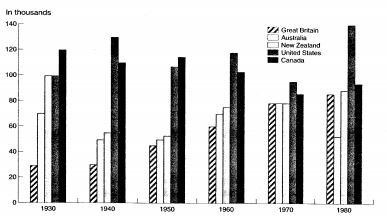The table below shows the figures for imprisonment in five countries between 1930 and 1980.
Write a report for a university lecture describe the information shown below.
The supplied bar graph provides information about the number of people who were put behind bars in Great Britain, Australia, New Zealand, United States and Canada from 1930 to 1980, a period of 50 years. Units are measured in thousands.
Overall, where the number of the imprisoned inclined throughout the given period in Great Britain, it remained fitful among all the other nations. The least captivity numbers in Great Britain were from 1930 to 1960, and in Australia in 1980. New Zealand had the highest incarceration rate in 1930. Canada had the distinction of highest imprisonments in 1930 and 1950, and the United States had the most people jailed in 1940 and 1980.
At the fleeting glance, the count of culprits jailed in Great Britain was around 30 thousand in 1930 and it increased eventually to about 80 thousand in 1980. The number for Australia slumped markedly from 1930 to 1950, and subsequently rose gradually till 1970. Thereafter, it again decreased sharply in 1980 to become the lowest among all countries.
Probing further, New Zealand put 100 thousand people behind the bars in 1930 and this figure took a nosedive in 1940 and remained constant in 1950. In 1960, it soared significantly to around 80 thousand and again remained constant before rising marginally in 1980.Moreover, the United States jailed 100 thousand convicts in 1930 and the number inclined sharply in 1940. The numbers fluctuated during the next decades and they reached the peak of 140 thousand in 1980. Canada, which had the most jailed individuals in 1930, went through mild ups and downs in its figures while exhibiting an overall curtailing pattern.

